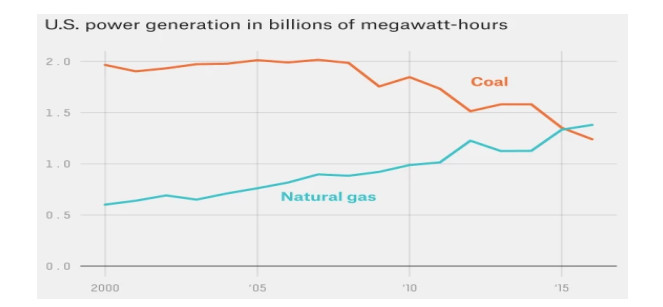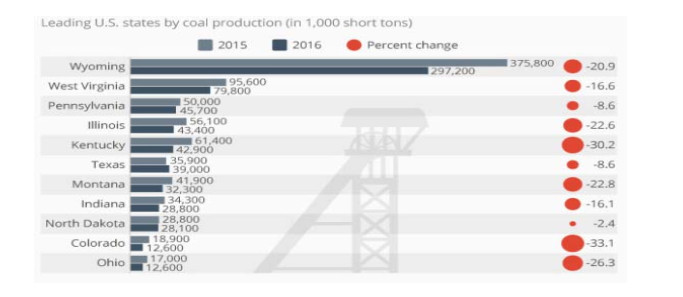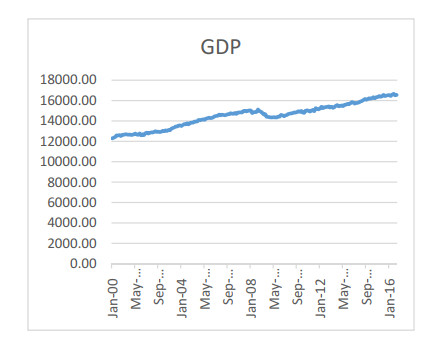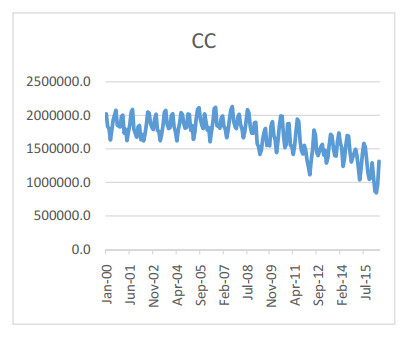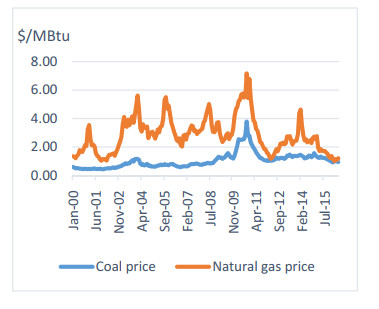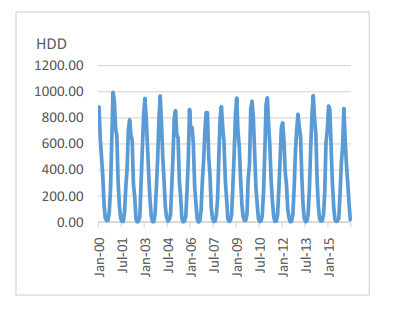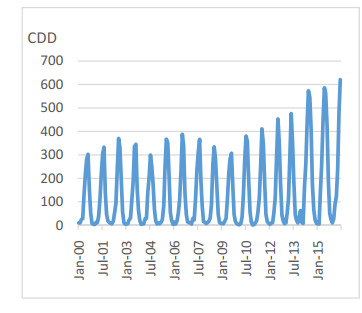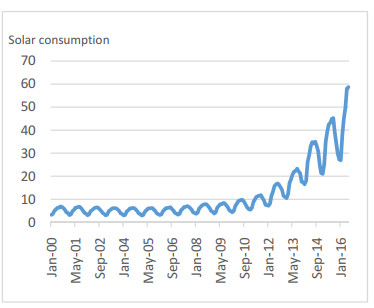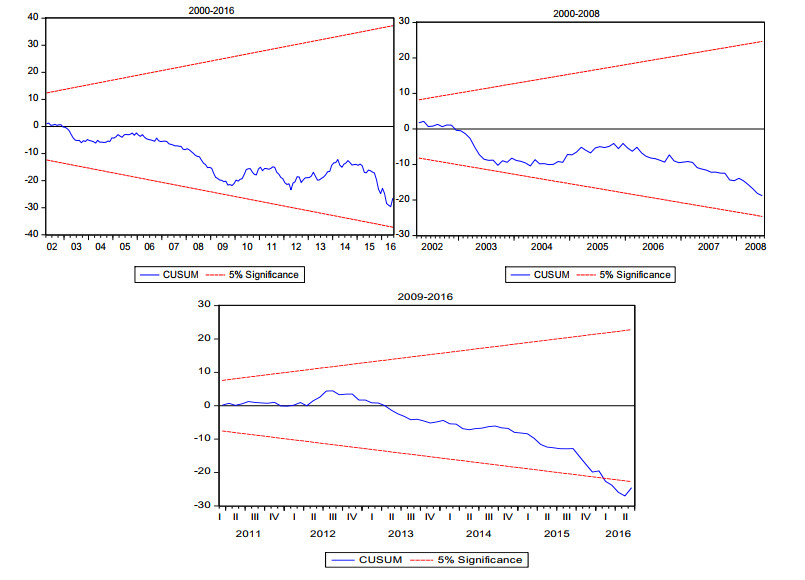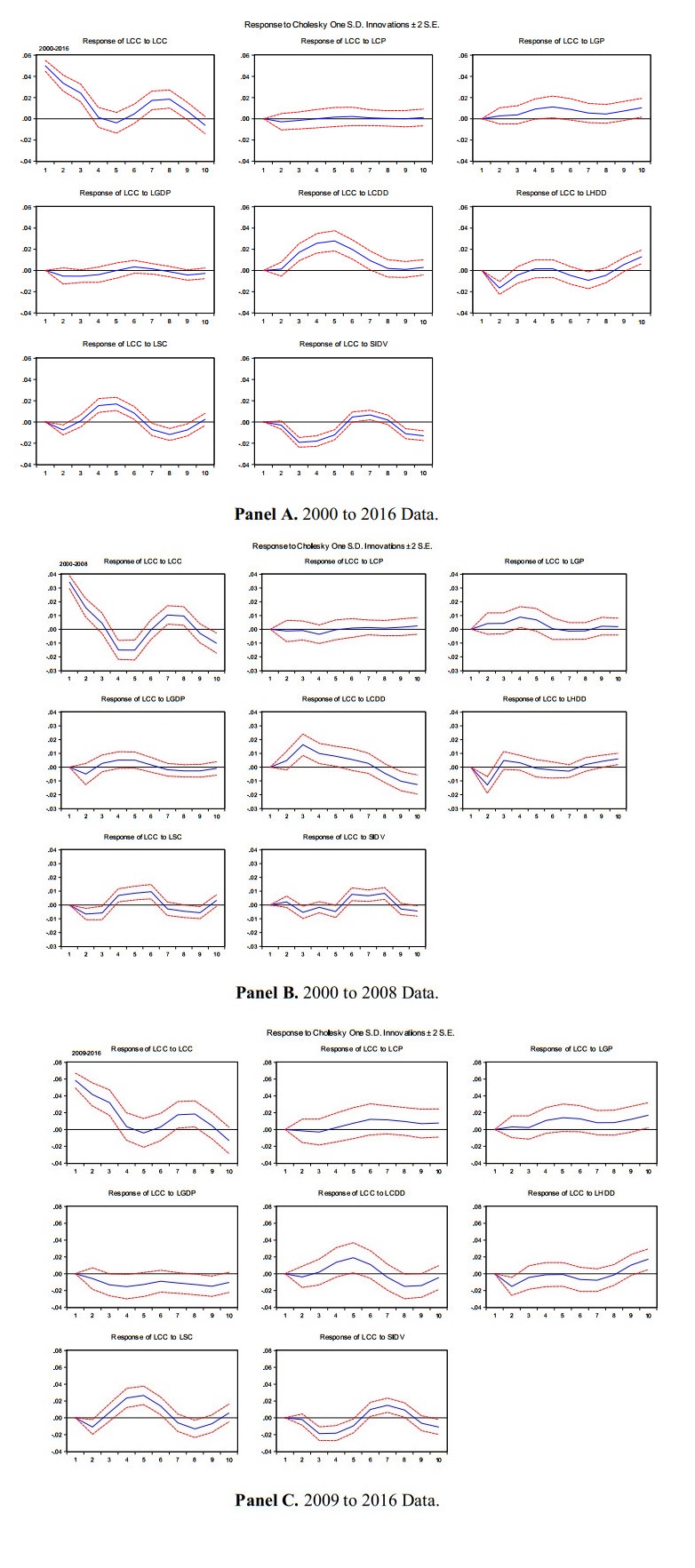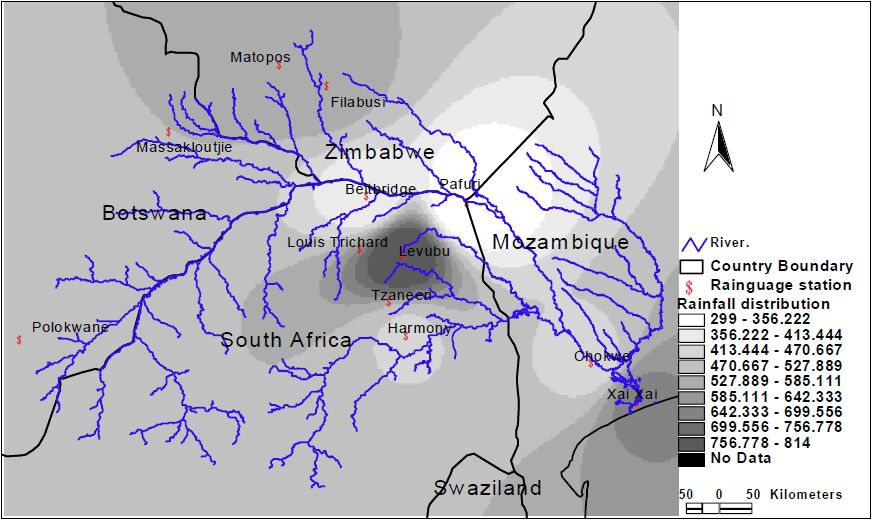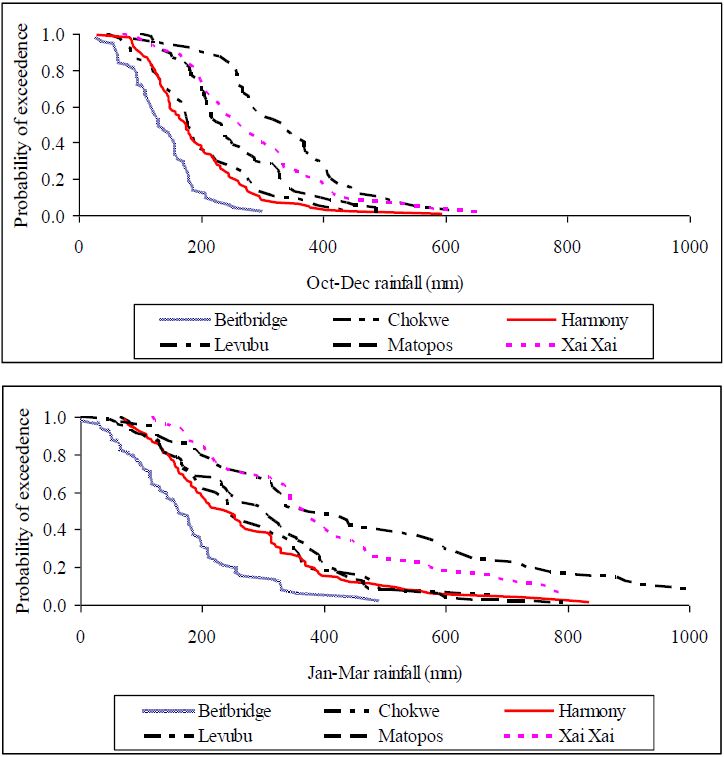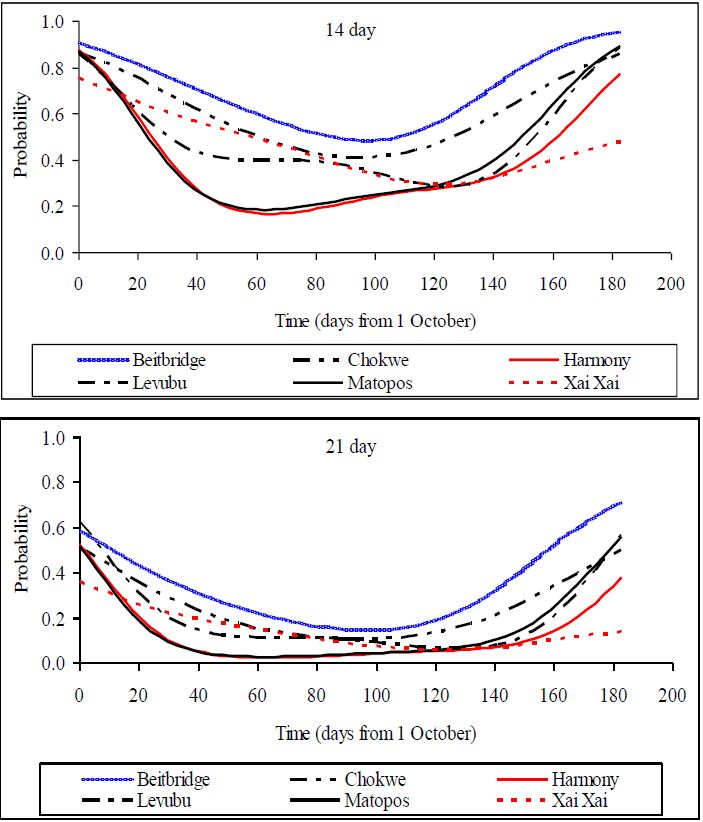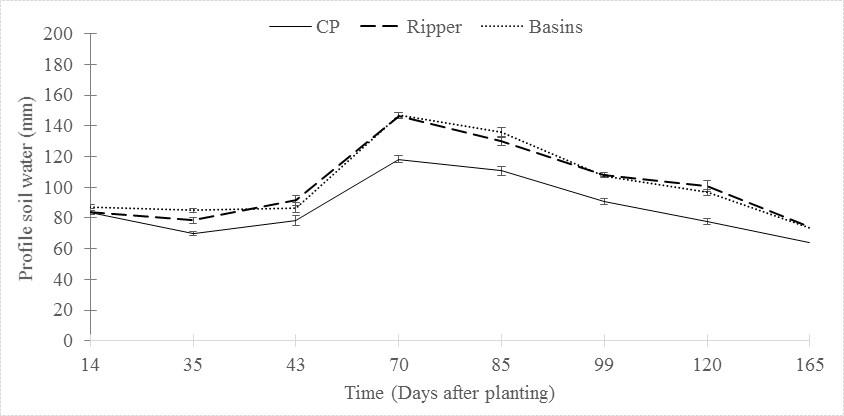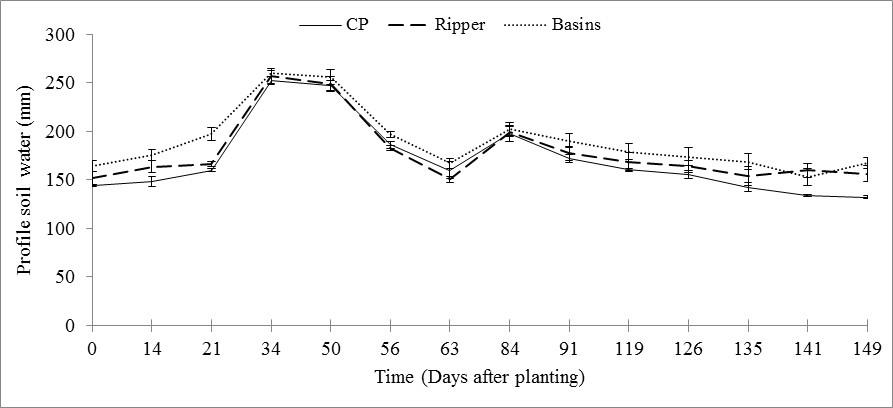Improvement of household food security in the Limpopo Basin has been elusive due to a combination of factors related to information and market constraints, but also farmers’ risk aversion induced by the high variability of rainfall during the growing season. The purpose of this study was to (1) characterize the rainfall and growing season patterns experienced by smallholder farmers, and (2) measure soil water dynamics in ripper and basin tillage systems being promoted in the semi-arid Limpopo Basin of southern Africa. The results show that the second half of the growing season receives more rainfall than the first half in the Limpopo Basin. However, rainfall is more variable during the January-March than the October-December period. Growing seasons start earlier and end later in the Mozambique part of the basin which is closer to the Indian Ocean. The Limpopo Basin is prone to two and three week dry spells with chances of 14 day spells higher (34–42%) than the 21 day spells (8–12%). The chances of 14 and 21 day dry spells increase substantially during the second half of the growing season. The 1980–1990 was one of the driest decades in the Limpopo Basin. Planting basin system conserved more soil water on sandy loam (18–24%) and clay loam (4–12%) soils than the conventional practice during flowering and grain filling maize growth stages. Ripper had 17–29% more soil water than conventional practice during flowering and grain filling maize growth stages. There is a high risk of dry spells and soil water deficits in smallholder cropping systems of the Limpopo basin. There is therefore scope in promoting rain and soil water management technologies, and good land husbandry in order to reduce risk of crop failure in the smallholder cropping systems.
1.
Introduction
A variety of energy sources and technologies are used in the United States (U.S.) to generate electricity with sources and technologies changing over time based upon price, efficiency, and environmental impacts. As the U.S. gravitates towards more efficient and sustainable energy sources, natural gas is seen as a transition fossil fuel, with coal-to-gas substitution expected to drive decreased coal consumption [2,3]. Thus, understanding the possibility for substitution between energy sources and the sensitivity of power utilities to changes in the prices of energy sources is essential when examining energy markets as policy makers seek to promote cleaner energy and enhance energy efficiency.
Electricity energy in the U.S. come from sources of coal (33%), natural gas (33%), nuclear (20%), hydropower (6%), and other renewable sources (7%) such as biomass, geothermal, solar, and wind [4]. Moreover, during 2011-2014 period, electricity from fossil fuels (coal, natural gas, and oil) has increased by approximately three percent. In this study, we focus on the substitution patterns between coal and natural gas. From 2005 to 2014, the extraction of natural gas has increased by 42% in the U.S. because of developments in hydraulic fracturing technologies. On the other hand, coal production has decreased by 17% from 2008 to 2014 [4].
Fuel switching, or the substitution of high-carbon with low-carbon energy sources, is one of the principal methods suggested to reduce carbon dioxide (CO2) emissions [5]. According to the U.S. EIA, the amount of CO2 produced when coal is burned is almost twice that of natural gas. Thus, utilization of natural gas in place of coal leads to a significant reduction in CO2 emissions when generating electricity. Natural gas also exhibited significantly higher rates of energy to electricity conversion efficiency rates compared to coal, with rates of 62-90% and 25-33% respectively [6,7]. As the majority of CO2 emissions originate from coal consumption, the ability to switch from coal to natural gas becomes an important instrument for energy and environmental policy makers.
The issue of energy demand and coal industry has also become the subject matter of scholarly studies that address various topics. For instance, Apergis and Payne (2012) examine renewable and non-renewable energy demand. They find that the demand for clean energy sources increases with the growth of an economy. Nonetheless, the relationship between economic growth and energy consumption remain a debate [8,9,10,11]. During early phase of economic development, environment degrades, and pollution increases with the income growth. However, environment enhances as economy depends on clean energy [12]. There exists literature about the linkage between energy prices and economic activity [13]. Apergis and Payne (2012) examined the relationship between coal consumption and economic growth for 25 OECD countries over 1980-2005. The findings show that there exists both short and long-term bidirectional causality between coal consumption and economic growth; however, the short run causality is negative. Policy towards lessening coal consumption might not have an adverse impact on economic growth. Economic growth reduces coal consumption as evident from the fact that proportion of coal use in electricity generation has been lessening around the world [14]. Using a panel of 10 hydrocarbon consuming nations, there exists short-run bidirectional causality between economic growth and energy consumption [15].
Other studies have also been examined regarding coal and natural gas. For example, Arezki et al. (2017) has studied the surge in the generation of shale gas in the U.S. energy markets [16]. The study finds that the shale gas revolution resulted in change in long-term gas price in the U.S. However, the difference in natural gas prices of natural gas is due to differences in its endowment of natural gas which is difficult to trade. The introduction of shale gas led to increase in gas supply impacted the long-run trend in gas prices. Neighbouring countries such as Canada and Mexico may directly benefit from exports of the U.S. shale gas. This is particularly boon for the U.S. economy when decreasing supply of conventional natural gas sources begun to reduce [17]. Prices of coal are determined by long-run contracts, while natural gas prices are determined territorially and state level demand supply relations [18,19,20]. There is a considerable amount of literature highlighting the relationship between crude oil and natural gas prices. This is on the grounds that coal and natural gas are substitute as inputs and utilized in the same market as factors of production. The impacts of natural gas prices on economic activities have been studied, however the related research have lesser insights for natural gas price volatility and coal industry.
There is some research [13,21] examining the link between energy prices, urbanization, and economic activity as well as several studies analyzing energy elasticities and fuel substitution in energy markets. Zhang and Lin (2012) investigate the impact of energy use and urbanization growth on CO2 emissions. Their findings from using an IPAT equation reveal that urbanization raises fossil fuel use and CO2 emissions gradually in provinces of China. Wang et al., (2019) argue that there has been a long-term co-integration relationship between energy prices, urbanization, and economic growth on energy consumption per capita in 186 countries. In this way, it is critical for policy makers and the coal industry to understand the evolving fuel-substitution capabilities at the national and state levels because of the electric power industry’s ability to respond to changes in the regulatory environment and relative fuel prices by adjusting fuel mix in electricity generation within and across utilities and states.
The main contribution of this study is to develop an economic framework for estimating the dynamic long-run linkages between coal plus natural gas prices and coal consumption in the U.S. economy. In addition, an Autoregressive Distributed Lag (ARDL) model is constructed to estimate these linkages. This research contributes to the literature of coal-natural gas linkages by utilizing a time series data model that allows exploration of both short and long-run relationships among variables. A novel contribution is estimating the responsiveness of coal consumption to natural gas price changes in the U.S energy market.
The empirical findings of the study can provide essential ramifications in regard to government policy. The results of this research have important implications for the Clean Power Plan (CPP), aimed at cutting carbon emissions from power plants. Although the CPP is rejected by the current administration, it is critical to examine the natural gas-coal prices relationship since natural gas is expanding its share of the electricity generation market at the expense of coal given the continued coal to natural gas switching. Given this background, the present research investigates the long-run and short-run dynamic response of coal consumption in the U.S. coal industry due to changes in energy prices and GDP. It is important to know the potential impact of a price-based approach is suitable to reduce emissions for the U.S. economy. The estimation of short and long-run elasticity of prices, both own and cross prices will help frame a proper energy and environmental policy.
2.
Methodology and data
Coal consumption is assumed to be a function of national income, coal and natural gas prices as well as exogenous factors such as weather, seasonality and efficiency. The functional relationship is assumed as follows:
where CCt is coal consumption in period t, Yt is the real GDP, CPt is the price of coal, GPt is the price of natural gas, HDD is heating degree-days, CDD is cooling degree-days, (SCt) is a control for solar energy use and SI is seasonality variable.
All variables are converted into natural logs, which helps to reduce the variability of the data series. Logarithmic transformation of the above function takes the following form:
where $ {\varepsilon }_{t} $ is the stochastic disturbance term and sidvt is a dummy variable for seasonality. 1
1 The seasonal dummy variable is one for winter (December, January and February) and summer months (June, July, and August) and zero for spring and autumn months.
2.1. Unit root test and structural breaks
Following Engle and Granger, we first test the unit roots of the variables used in the study to confirm their stationarity by performing the augmented Dickey-Fuller (ADF) and the Phillips-Perron (PP) tests. If any variables are found to be non-stationary, a first difference is applied to estimate the long-run and short-run dynamics of the variables considered in our study. Tables 1 and 2 presents the results of ADF, PP and Bound tests for each variable considered at their levels and first difference. Zivot-Andrews [22] structural breaks are calculated to find unit roots and the structural break of the variables used, particularly CC and prices of coal and natural gas which are important with respect to the shale gas revolution. The most significant structural break occurred in July 2008 for CC, coal price, natural gas price and GDP.
Table 2 presents the results of F bound test, which indicate that calculated F-statistics for all variables are higher than the upper bound critical value at a 5% level. This indicates that a long-run cointegration exists linking the dependent and independent variables.Table 2. Results of F bound test.
2.2. Autoregressive Distributed Lag (ARDL) model
The ARDL model is ideal for our analysis because it can be utilized whether the variables are stationary, non-stationary, or some combination of both. This helps to address the issue of spurious regression before testing for cointegration [23]. The ARDL model also avoids the problem of low power in detecting cointegrating relationships irrespective of the length of data. Using ordinary least square estimation technique the log-linear functional form of ARDL model can be represented as follows:
where ∆ is the difference operator and $ {\varepsilon }_{t} $ is the error term. The optimal lag length for each variable is determined using Akaike’s information criterion [24]. Equation (3) was estimated utilizing the ARDL approach to determine if the dependent and independent variables in each model are cointegrated. A joint F-test was conducted on the lagged log-level variables while the differenced variables have no direct impact on the bounds cointegration test [23]. The F-statistic investigates the joint null hypothesis that the coefficients of the lagged log-levels are equal to zero which suggests that no cointegrating long-run relationship exists. The Wald test or joint F statistics is utilized to examine the null hypothesis of cointegrating linkages.
The long-run dynamics are estimated as:
Parameters pertaining to short-run dynamics are estimated by an Error Correction Model (ECM) attached with the long-run estimates.
where $ \varnothing $ is the coefficient of the error correction term, ECTt-1 is the lagged error correction term which is based on the residuals from the long-run equilibrating relationship. Thus, ECTt-1is the speed of adjustment for long-run equilibrium each period in the dependent variable when a change occurs in other variables, m is the lagged length, and $ {\varepsilon }_{t} $ is the serially uncorrelated error term.
Following Brown et al. (1975), the cumulative sum (CUSUM) test and cumulative sum of squares (CUSUMSQ) are applied to assure the stability of the ECM. Stability of the model can be ensured if plots of CUSUM or CUSUMSQ measurements remain inside basic limits of the 5 percent significance level.
Estimation is based on monthly data for January 2000 to June 2016. The dataset consists of 198 observations of the eight variables described in equation (2). The data was collected from the U.S. EIA, Federal Reserve Economic Data and the Bureau of Labor Statistics[25,26,27]. The dependent variable, monthly coal consumption, is measured in million British thermal unit (MBtu), coal and natural gas price are measured in U.S. dollar/MBtu. The amount of solar consumption in the U.S.’ energy market is measured in trillion Btu. Data for HDD and CDD were retrieved from the National Oceanic and Atmospheric Administration. Time series data on real GDP came from Bureau of Economic Analysis. July 2008 was identified as the breakpoint for coal consumption data based on the shale gas revolution in the U.S.’ energy market and a Zivot-Andrews test. Therefore, we split the data into two subsamples: the pre-shale gas period of 2000-2008 and post shale gas period of 2009-2016. All nominal variables were converted into real. Table 3 presents the summary statistics of the data.
At the same time, U.S. electricity generation from coal has decreased along with domestic coal consumption (Figure 1). As a result, the production of coal has decreased over past two decades. As shown in Figure 2, decreasing coal extraction has affected labor market and income for local and state economies in the most producing coal states in the U.S. 2[4]. Moreover, efficiency and lower natural gas prices have led to more consumption of natural gas and less production of coal due to the development of shale gas resources in the U.S. [4].
2 There are 11 states including Wyoming, West Virginia, Pennsylvania, Illinois, Kentucky, Texas, Montana, Indiana, North Dakota, Colorado, and Ohio.
As far as trends of the variables are concerned, Figure 3 presents the monthly GDP of the U.S from 2000 to 2016. It can be observed that GDP witnessed upward trend till May 2008, then slowed down due to financial crisis. Since March 2009, GDP continued upward trend and continued till then. As indicated from the Figure 4, coal consumption exhibited a falling trend throughout the study period. On the other hand, coal prices did not show volatile price behavior except for a period in 2010 and 2011 (Figure 5). Lastly, natural gas prices followed a range bound pattern throughout the study period, varies between $1 and $7/MBTU (Figure 5). Figures 6 and 7 show the trend of monthly heating degree-days and cooling degree- days. Figure 8 is monthly solar consumption which increased dramatically towards the end of the time period.
3.
Results and discussion
We analyse the long-run and short-run linkage between coal consumption (CC) and its determinants separately from 2000 to 2008 for pre-shale and 2009 to 2016 for post-shale gas due to a structural break in the U.S. energy market.
Long-run coefficients for all three time periods are reported in Table 4 where CC is treated as the dependent variable. For the entire period there exists dynamic long-run relationships between CC and all variables based upon statistically significant coefficient estimates. Although the observed elasticities of HDD and CDD are small, the results are the opposite of those expected. These findings suggest that other energy sources may be used during winter and summer time since there is negative relationships between HDD, CDD, and CC.
The income elasticity for the entire period is −0.41 and statistically significant so that an increase in GDP leads to a fall in CC. The results provide evidence that there is a significant negative impact of GDP on coal demand, implying that coal is an inferior good. Also, this finding implies that economic growth has stimulated declining CC via substitution toward more efficient and environment friendly energy sources.
During the pre-shale period long-run linkages are found to exist between CC and coal price, natural gas price, HDD, and CDD. The other explanatory variables do not show long run linkages. There exists statistically significant own-price and cross-price elasticities for CC. During the post-shale gas period no statistically significant long run linkages are observed. While this result is difficult to explain, further discussion of this result will be provided in the conclusions.
The coefficients for cross-price elasticities over the entire period and pre-shale are positive and statistically significant, suggesting that coal and natural gas are substitute goods in U.S. energy markets. Comparing this finding to the literature reveals that coal-natural gas cross-price elasticity during the entire period is higher than a previous estimate by the EIA (2012) at 0.17. Moreover, the own-price elasticity is lower than the cross-price elasticity over the entire period.
Table 5 presents the short-run coefficient estimates for the ECM of ARDL equations. The ECT coefficient gives an indication of short run deviations from the long run equilibrium. As expected, the adjustment variable ECT(-1) in each of the three time periods is negative and statistically significant at the 1% level. These results ensure that stable long-run relationships exist among variables in the CC model. The magnitude of the error correction coefficient implies that disequilibria in the model is corrected by approximately 0.95 percent every month over the entire study period. During the pre-shale period, CC adjusts towards long-run equilibrium much faster compared to the post-shale revolution period. CC, coal-natural gas prices, GDP and other explanatory variables have a tendency to converge towards an equilibrium path in the long run.
Table 5 also shows that the estimated short-run elasticities of all variables, except for CDD, are statistically significant over the entire period. In the pre-shale period, the variable coefficients of coal price, the price of natural gas, GDP and solar consumption are not statistically significant. The results also show that HDD and CDD coefficients are statistically significant at 1% for the pre-shale period. In the post-shale period, coal price, natural gas price and solar consumption have statistically significant coefficients in determining CC. There is no statistical significance for CDD, HDD, and GDP coefficients.
Table 6 provides the results of several diagnostic tests for serial correlation, stability, and normality. The results show that there exists normality, no serial correlation, and no zero coefficients. Figures 3-9 presents the results of CUSUM and CUSUMSQ tests for stability of the model proposed by Brown et al. (1975) to the residuals of the ECM. These tests suggest that the estimated parameters are stable over time and emphasize the existence of a dynamic long run linkage between CC and explanatory variables.
As a result, we can argue that there exists a long-run relationship among the coal consumption and the independent variables of coal price, the price of natural gas, economic growth, and weather conditions. The empirical results obtained in this study are consistent with previous studies. Therefore, these findings are in line with previous literature estimates [5,28], who found that natural gas is an alternative for coal in energy market and power plants.
During the post-shale gas period of 2009-2016, there are not any statistically significant long run linkages between coal consumption and the independent variables. The cross-price elasticities of coal consumption and natural gas, as expected, are positive at 0.29 for entire period, 0.05 for pre-shale, and 0.002 for post-shale gas. The coefficients for the entire period and pre-shale are statistically significant which suggests that coal and natural gas are substitute goods in U.S. energy markets. For the entire period, a 1 percent decrease in natural gas price leads to 0.3 percent decrease in coal consumption. Comparing this finding to the literature reveals that coal-natural gas cross elasticity during the entire period is higher than a previous estimate by the EIA (2012) at 0.17. Moreover, the own price elasticity is lower than the cross-price elasticity over the entire period.
Finally, the Impulse Response Function (IRF) is employed to investigate how coal consumption respond to shocks in other variables included in the model (Figure 10). Results of IRF in the period of 2000-2008 are reported in the panel B from Figure 10. The impulse is coal consumption, the responses from natural gas price and HDD shocks have a positive movement but obvious fluctuation during period 6. The responses to coal price and GDP shocks are negative and or positive, and there are distinct effects on the period 2 and 4. The response to CDD is positive until period 7 and decreasing into negative over the final three periods. The responses to solar energy consumption and seasonal dummy changes by coal consumption show fluctuation below and above zero throughout the time periods.
The IRFs in the period 2009-2016 in panel C from Figures 3-10 show that the response of coal consumption to a one standard deviation change in coal price as initially zero or negative through period 4 and positive thereafter until the end of the time horizon. Response of coal consumption to natural gas prices starts at zero and then remains positive throughout the entire period. The response of coal consumption to GDP changes also starts at zero and remains consistently negative throughout the entire period. The response of coal consumption to CDD changes is that it increases initially but later decreases and touches the zero line at period 7 and remains negative thereafter. The response of coal consumption to HDD changes is mostly negative or zero until period 8, after which it remains positive until the end. The response of coal consumption to solar consumption and the seasonal dummy variable both shows fluctuations between negative and positive throughout the entire period. Overall, the results provide evidence that there exists a consistency with the empirical results from ARDL model in the three periods of study.
4.
Conclusions
In this study, we have estimated long-run and short-run responses of coal consumption in the U.S. energy market to changes in coal and natural gas prices, GDP, HDD, CDD, solar usage, and seasonality. The main purpose of these results is to reveal the dynamic linkages among the variables by using an ARDL approach to examine energy switching from coal to natural gas. Long-run results show that the impact on coal consumption from natural gas prices is statistically significant and positive over 2000-2016, suggesting that these two energy inputs are substitutes. In addition, we observe that in the short-run and long-run, coal consumption is inelastic with respect to both coal and natural gas prices. The effect of solar energy consumption and economic growth on coal demand are statically significant and negative. Overall, the income elasticity estimate suggests that coal is an inferior good. This implies that economic growth prompts a decrease in CC and increases in other more efficient sources such as natural gas.
Since there are not statistically significant, long-run impacts from any variables on coal consumption in the post-shale gas time period, this suggests the expansion of shale gas production has substantially changed the factors that determine coal consumption. However, decreasing natural gas prices relative to coal prices during this time period along with a statistically significant short-run impact might illustrate short term substitutions of natural gas for coal still exist. This substitution has resulted in important shifts in the U.S. energy market and a reduction in CO2 emissions. These results are in line with previous studies [5,7,28,29]. Lastly, economic growth and maintaining the growth of the U.S economy has led to a path of consuming more low carbon energy and less coal. To maintain this energy path, energy policies such as renewable portfolio standards implemented by states around the U.S. should aim at increasing the use of both natural gas and renewable energy.
These empirical results not only contribute to advancing the current literature, but also deserve certain attention from energy policy makers in the U.S. market. As capacities of power plants are decreasing and new capacities are being established to replace them, power firms are promoting to use more efficient and cost-effective energy sources (i.e., natural gas) to build new power plants over coal-fired plants.
Finally, this study only provides a primary interpretation of the dynamic response of coal consumption to energy prices and GDP in the U.S., hence, it excludes more explicit examining about the CO2 emissions and structural changes among various economic sectors. Future work could be more directly investigate the roles of economic activities, sectors of economy, and other excluded factors in explaining the substitution of energy resources not only in the U.S but also spillover effects of coal consumption among countries. We look forward to future study along these lines. Given the coal issue of the energy market in the U.S., more study needs to be undertaken to offer a comprehensive resource for policymakers pursuing actual solutions to alleged problems surrounding this industry.
Conflict of interest
Neither author has any been affiliations with or involvement in any organization or entity with any financial interest (such as honoraria; educational grants; participation in speakers’ bureaus; membership, employment, consultancies, stock ownership, or other equity interest; and expert testimony or patent-licensing arrangements), or non-financial interest (such as personal or professional relationships, affiliations, knowledge or beliefs) in the subject matter or materials discussed in this manuscript.









 DownLoad:
DownLoad:
